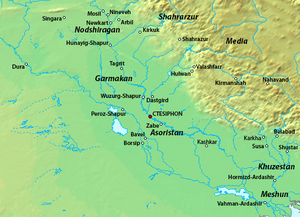Muslim conquest of Khuzestan
| Muslim conquest of Khuzestan | |||||||
|---|---|---|---|---|---|---|---|
| Part of the Islamic conquest of Persia | |||||||
 Map of Khuzestan (far right) and its surroundings |
|||||||
|
|||||||
| Belligerents | |||||||
|
|
|
||||||
| Commanders and leaders | |||||||
|
|
|
||||||
| Casualties and losses | |||||||
| Heavy | Unknown, probably heavy | ||||||
The Muslim conquest of Khuzestan took place from 637/8 to 642, and ended with subjugation of the rich Khuzestan Province to the Rashidun Caliphate.
The Arabs started invading Khuzestan in 637/8—around the same time when Hormuzan, a nobleman of high status, had arrived to Hormizd-Ardashir after suffering several defeats to the Arabs in Asoristan. Hormuzan used the city as a base to mount his raids in Meshan against the Arabs. The young Sasanian king Yazdegerd III (r. 632-651) supported him in these raids, and believed that it was possible to regain the territories which had been taken by the Arabs. After some time, Hormuzan clashed with an Arab army to the west of Hormizd-Ardashir, but was easily defeated and retreated back to the city, where he asked for peace. The Arabs agreed in return for tribute, which Hormuzan accepted. However, he soon stopped paying tribute, and raised an army of Kurds (a term then used to describe Iranian nomads).Umar, who was caliph of the Rashidun Caliphate, responded by sending an army under Hurqus ibn Zuhayr al-Sa'di, who defeated Hormuzan in 638 at Hormizd-Ardashir, and forced the city to pay jizya . Meanwhile, Hormuzan fled to Ram-Hormizd. He then once again sought a peace treaty and was granted one in return for tribute.
However, he once again stopped paying tribute and continued his resistance, but was again defeated in a battle. Meanwhile, the cities of Khuzestan were slowly one-by-one conquered. Sometime later in 641, after a defeat at Ram-Hormizd, Hormuzan fled to Shushtar, and was defeated near the city, which cost him the lives of 900 of his men, while 600 were captured and would later be executed. Nevertheless, he managed to reach the city. The Arabs then laid siege to the city.
Fortunately for Hormuzan, Shushtar was well fortified due to the rivers and canals that surrounded it on almost all sides. One of them was known as Ardashiragan, named after the first Sasanian king Ardashir I (r. 224-240). Another known as Shamiram, named after the legendary Assyrian Queen Semiramis. The last one mentioned was known as Darayagan, named after the Achaemenid king Darius I (r. 550–486 BCE). There are several versions of the how the city got captured; according to al-Tabari, during the siege, an Iranian defector named Sina (or Sinah) went to al-Nu'man and pleaded for his life to be spared in return for helping him how to show a way into the city. Al-Nu'man agreed, and Sina told him the following thing; "attack via the outlet of the water, and then you will conquer the city."
...
Wikipedia
